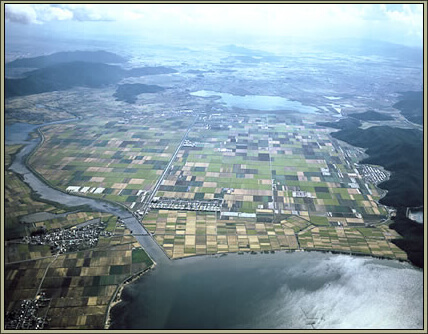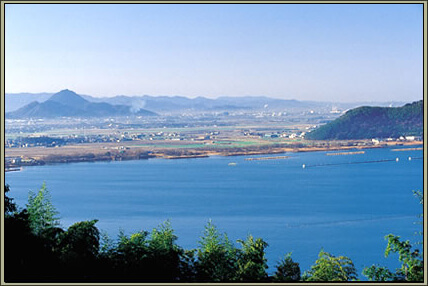

Land reclamation was carried out at Lake Biwa as well.
Lake Biwa once had about 40 satellite lakes, both large and small. Above all, Nakanoko (literally “inside lake” in Japanese) which was comprised of four satellite lakes, including Dainakanoko (“big inside lake”) and Shounakanoko (“small inside lake”), was larger than Lake Suwa in Nagano Prefecture.
Water level of Lake Biwa was constantly lowered as improvement works along the Yodo River progressed. Paddy fields in the Kotou region attracted more attention during the time of World War II when policies of increasing food production were promoted.
Rice grown in this area was well-known as very flavorful “Goushuumai”. In addition, since Lake Biwa was a freshwater lake, there was no worry about salt damage. It was truly an ideal location for land reclamation.

Land Reclamation at Dainakanoko
This area belongs to the Setouchi climate zone and has relatively small rainfall. In the early Showa era, local farmers experienced a severe economic recession and perpetual conflicts over water-use. The one which was famous among them was the well-known conflicts along Inugami River. In the case of the one that arose during the drought of yr1932, about 10 people lost their lives and a roughly 300-strong police unit fulfilled their duty for three days to settle down the situation. As the water level of Lake Biwa lowered, inundation of paddy fields decreased but critical water shortages became serious in many farming communities where farmers traditionally relied on water from pump irrigation.
In the same year of 1932, a modern land improvement project was launched that included a concrete gravity dam, which was the largest for agricultural purposes at the time in Japan, and thus, this was completed in 1946.
This was followed by the prefectural irrigation project of Yasu River, the largest river flowing into Lake Biwa, which started in 1938. This was a large-scale land improvement project with a beneficiary area of approximately 4,000 hectares.
Meanwhile, as agricultural development projects in Lake Biwa and improvement works in Yodo River progressed, a certain proposal was kept in discussion. In 1935, the Proposal of the Embankment Along the Lake was announced which involved construction of the high dikes around Lake Biwa, thereby enabling the water level of the lake to be maintained at a higher level than before so as the surplus water to be used for hydroelectric power generation and industrial purposes. This proposal was supported by downstream residents, but opposed by those living around the lake due to their serious concern about flood, and was finally abolished.
However, it was in these times that the concept of the Lake Biwa Integrated Development Plan came out which spent nearly 30 years just getting through the preparatory coordination.

Lake Biwa (and Oumifuji, the “Mt. Fuji of Oumi” on the Left)
Furthermore, The Ministry of Agriculture, Forestry and Fisheries came up with the donut-shape proposal, wherein Lake Biwa would be separated into the inner lake and the outer one. The proposal of Kansai Electric Power Company: building dams at two locations along the Seta River. The proposal of the Ministry of Land, Infrastructure, Transport and Tourism: keeping a giant balloon inside Lake Biwa (so it could be inflated during droughts and deflated during floods), and Many other ideas such as taking water in from the Sea of Japan.
But water problems always involve conflicts of interest. Stakeholders were Shiga Prefecture, Kyoto Prefecture, Osaka Prefecture, relevant ministries, and electric companies. Negotiations among these parties were moved from the stages of Kinki region to Tokyo and finally the National Diet, where discussions became bogged down. Concerning The Lake Biwa Integrated Development Plan, the importance and urgency were pointed out, but was never advanced any further.
Times changed drastically from the post-war economic recovery period to the rapid economic growth period, and further to the period of various pollution problems. At each turning point, the Development Plan was amended, adjusted, and disputed further.
The focus of the discussions was the volume of water which could be developed and the water level of Lake Biwa. Through high-level talks between concerned organizations, the issues were finally resolved in 1972. The Cabinet ultimately approved the Lake Biwa Integrated Development Plan Special Measures Law. The duration of this law was initially stipulated to be 10 years, and afterward in 1982 it was extended for another 10 years according to the alterations of the project. Further, in 1992, five-year extension was again decided.
Among the discussed issues it should be noted that the focus was shifted from water volume to quality, namely to sewage and the installation of waste disposal facilities, and further to the consideration for environmental protection for Lake Biwa such as publicized parks and nature reserves.
The concept of “integrated development” itself gradually came to involve a new sense as time went.
